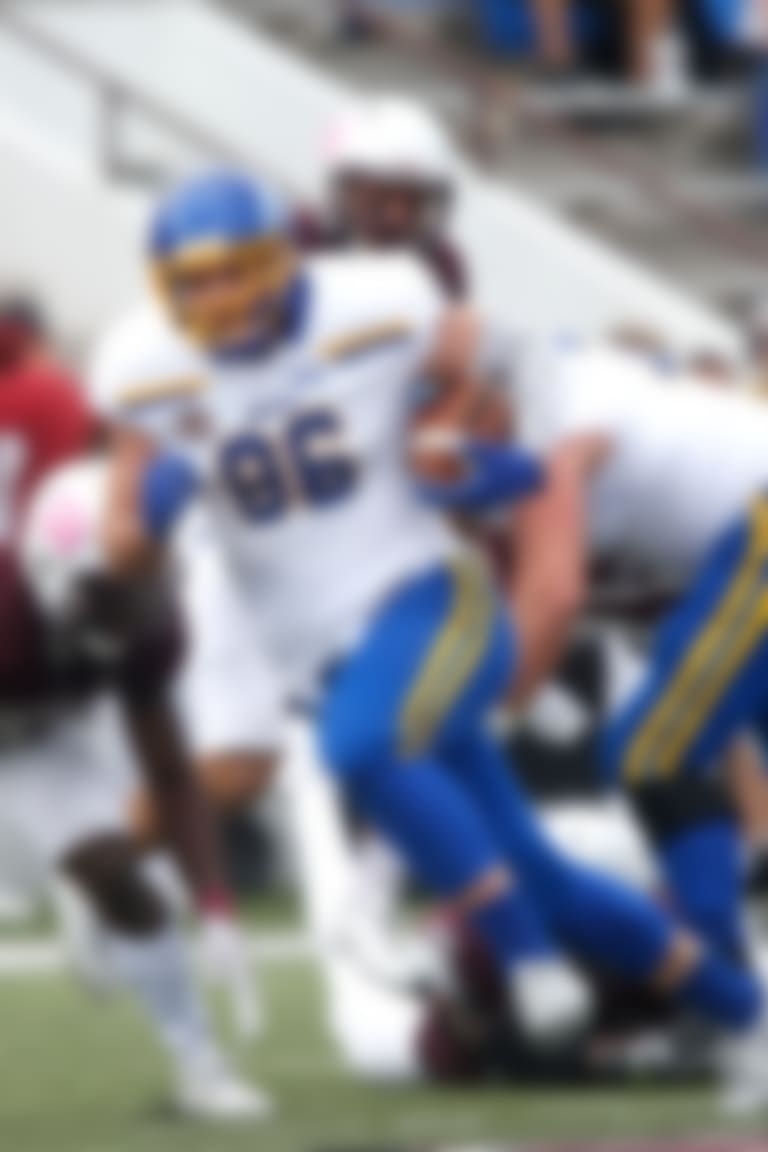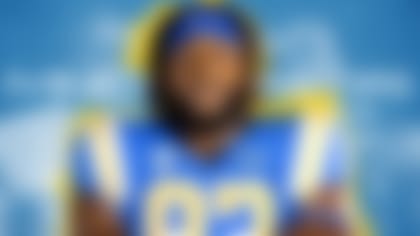He was named after his father's favorite team and rides a unicycle in parades. Dallas Goedert is also college football's best-kept secret, but maybe not for too much longer.
By Chase Goodbread | Published Oct. 25, 2017
BROOKINGS, S.D. -- The alarm clock went off in 2015, awaking perhaps the sleepiest of the 2018 NFL Draft's sleepers.
Dallas Goedert's name and face are getting around now like never before, but at the time, he couldn't have been more anonymous. His rising popularity was later marked within state borders on a South Dakota State football promotional billboard along I-29 in the equally sleepy state of South Dakota.
Almost everything about Goedert's path to becoming a dominant player at SDSU was unorthodox, unique, and very much his own. Top draft prospects typically come from an athletic background of intense competition and highly specialized training.
Goedert didn't.
Most are heavily recruited out of high school, identified and targeted by top college programs even before they can shave or drive a car.
Goedert wasn't.
"I didn't beat down his door to get him here," SDSU head coach John Stiegelmeier admits about his former walk-on.
At his own pace, and with his own style, Goedert's become a favorite son of Britton, S.D., his hometown of only 1,250 residents. Scouting whispers are that he has the requisite physical tools to be the NFL's next tight end matchup nightmare. Scouts will find their background work on the star of the FCS Jackrabbits to be, fittingly, something of a rabbit hole itself -- full of the atypical.
It took about 17 years for Goedert to choose football as his primary sport, but his father, David, had him marked for the NFL from the very beginning. He was huge at birth -- 10 pounds -- and David named him Dallas for the Dallas Cowboys, his favorite team, even though Goedert eventually became a fan of the Green Bay Packers.
As a kid, however, football was just one among a long list of sports Goedert notched in dot-on-the-map Britton. NFL scouts who prefer multi-sport athletes over specialization will marvel at Goedert's background of activities, a list as diverse as it is long: football, wakeboarding, track, ice skating, basketball, kayaking, soccer, swimming, softball, downhill skiing, wrestling, and ... unicycling.
Goedert's grandfather, Gordon Phillips, taught his five daughters to ride a unicycle and perform in local parades. Dallas eventually learned as well, but it took some nudging.
"I practiced some and never got it, but my grandpa called one day and said, 'Your cousin Drew has learned it, can you do it yet?' " Goedert recalled. "I said, 'Oh, yeah, I learned it, too,' even though I really hadn't. Well, then, I had to learn it."
He learned it alright, well enough to ride one with a 6-foot seat, so tall Goedert had to mount it from the side of Phillips' pickup truck. And it's not something he left behind in childhood; he rode it as recently as the summer of 2016 at the Lake City Fourth of July parade, a 20-minute ride from Britton down Highway 10.
"If I called him right now and asked him to do another parade, he'd do it in a second," said Goedert's mother, Mary.
The skill has paid football dividends, as Goedert has remarkable balance to absorb contact after the catch and shake free from tackles.
"The 6-footer is always the top attraction in a parade," he said. "It's pretty cool."
That flare for showmanship has its roots. Goedert's paternal grandfather, Clayton, used to walk around on his hands in nearby Veblen, often and well enough that a traveling circus came through and tried to recruit him. But the Goedert family tree is loaded with athletes, not just acrobats.
His grandmother, Bev Phillips, once scored 65 points in a high school basketball game, and that was in 1953, long before the dawn of the three-point shot. His mother and aunts were champion softball players, and David Goedert was a champion discus thrower. His sister Megan played volleyball at Presentation College in Aberdeen, S.D., while sister Emily played volleyball and basketball at Valley City State.
Football stars? Goedert is the first. But athletes populate the lineage on both sides of the family.
Goedert is bluntly honest about something few athletes would admit: He just didn't work all that hard to improve himself at the high school level. He didn't have to. He was always naturally bigger and stronger than his competition, and because he was planning to pursue basketball rather than football, the weight room never really appealed.
A couple years ago he returned to Britton-Hecla High and gave a speech at the annual sports banquet. He implored the Braves athletes to put more effort into their training than he did. Two weeks ago, sitting in the SDSU players' lounge with "The Price Is Right" providing background noise, he stared right through Drew Carey as he acknowledged it again.
"As a kid, you always had an excuse," he said. "I played around with weights sometimes just to see what I could do, but I never was on a program."
Goedert decided on football over basketball just before his senior year, but being the best athlete in the area had drawn just one scholarship offer -- to Northern State, a Division II school close to home -- and Goedert had ambitions to play on a higher level, even if it meant walking on.
In his senior year, his football team traveled an hour and a half to play Milbank High near the Minnesota border. In attendance was former SDSU offensive line coach Carl Larson, who at the time was the minister at American Lutheran Church in Milbank. He saw something in Goedert worthy of a phone call to his former boss in Brookings.
"He started out playing inside linebacker on defense. He ended up playing quarterback, receiver, tight end and running back on offense. He was the whole team," Larson said. "I called coach Stig and told him, 'This guy's a player.' That spring, he was back in Milbank with the track team. The best (discus) throwers there were throwing it maybe 120, 125 (feet). He came up and whipped it 156. So I called coach again."
Both times, Stiegelmeier took the call, but he'd never even heard of the kid. In fact, in his 30 years at SDSU as both an assistant and head coach, he'd never even had a player from Britton on the team. Between the football and track seasons, Stiegelmeier took the trip to Britton to watch Goedert play a basketball game, and came away with mixed feelings.
"I saw a big guy who was athletic, but a guy who didn't play very hard. And I was concerned about that," said Stiegelmeier, who wasn't ready to make a full commitment to Goedert. "We asked him to walk on, and he took the bait. The way he's grown since then is just amazing. He has made himself, coming from that community, into what he is today."
After two years in the program, Stiegelmeier put Goedert on a 40-percent scholarship. A year after that, he went to 70 percent, then finally, a full ride. On the heels of that came his 2016 breakout season: 92 catches, 1,293 yards and 11 touchdowns, including a ridiculous one-handed TD catch against Drake that made an ESPN SportsCenter Top 10 list. Referred to around the program simply as "The Drake Catch," the highlight became part of the pre-game hype reel on the SDSU video board last season, ending with Goedert pointing a football -- with one hand, of course -- into the camera.
Indeed, the minister's recommendation proved to come straight from the heavens. But doing it at an FCS school and in the NFL are two very different things.
Scouts wonder how Goedert will react when he's dropped into an NFL training camp environment, with 90 grown men battling like piranhas for one of 53 roster spots.
"The measurables are what they are, and they're very good. From that standpoint, he'll be as good as anyone his size," an AFC scout said. "As a small-town guy who sort of came out of nowhere though, teams are going to be more interested to know what makes him tick on the inside."
Two SDSU coaches corroborated that, saying scouts who have come through Brookings are primarily asking questions centered around Goedert's character, work ethic, and willingness to block. After all, as a pass catcher, his film speaks for itself. And if you think it's all been accomplished against FCS competition, you'd mostly be right. But consider what he did in the 2016 season opener at TCU: 5 catches for 96 yards and a touchdown.
Goedert gave brief consideration to leaving SDSU last year to enter the 2017 draft, and interest from agents came as a shock to the family. The agents ultimately advised Goedert that the strength and depth of the 2017 tight end class -- five of the first 45 selections were tight ends, including three of the first 23 picks -- made it wise for him to stay in school for a fifth year. He listened. And now he enters the 2018 draft as one of the top tight end prospects with a degree in operations management.
Scouts project Goedert as a second-day pick in the draft (Rounds 2-3), possibly the first taken at his position. They see the speed, quickness and balance of a big-play threat, and size that will make him a mismatch for smaller defensive backs. Meanwhile, his blocking has developed enough to be placed in the asset category.














